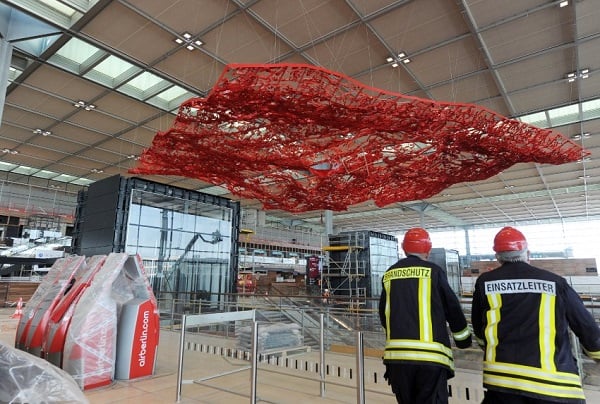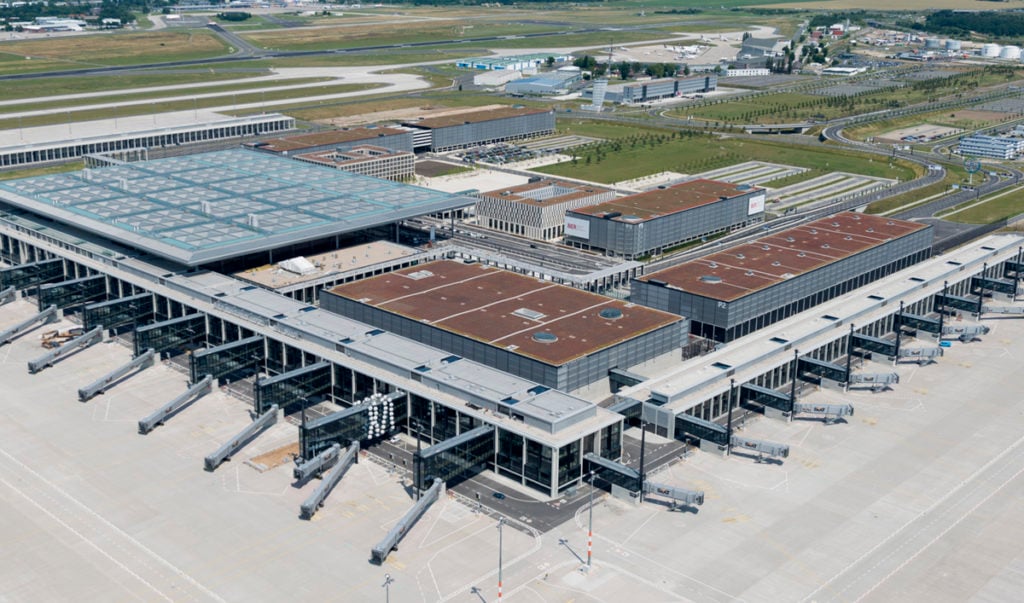Officials now estimate that the long-delayed Berlin Brandenburg International Airport (BER) will not open before 2016. That’s four years after its most widely discussed opening date, June 3, 2012, and six after the initially planned unveiling in 2010. Meanwhile artworks by Pae White, Matt Mullican, Olaf Nicolai, Takehito Koganezawa, Björn Melthus, and collective STOEBO sit installed and yet unseen. That is, save the workers attempting to fix a myriad of electrical and fire safety system issues that prompted the delays—and a €160,000 (US$219,000) per month cleaning crew, who makes sure that (among other things) the works don’t accumulate dust.
We’ll leave more heady questions of, “Is public art, public art if it can’t be seen by the public?” for another day. But there are more concrete urban development issues at play, which the artworks exemplify. A nagging feeling persists that the structure will be outdated on its opening day: not offering sufficient passenger capacity and under performing where profitability is concerned. Some of the artworks, too, may get crusty, especially those with a digital bent.
On the operational side, bigger planes mean a better chance of being in the black, and BER only has one A380-capable jetway. It’s this jetway that boasts non-Berliners first access the airport’s artistic offerings. Olaf Nicolai’s Gadget sees a string of white glass beads wrapped around the structure. The work itself remains on form where public art is concerned. However, its effect is now somewhat ironic, pointing out ever so prominently the bridge that was intended as a highlight for BER and is now, in its solitude, a prime example of what could be a future undoing for the airport’s balance sheet.
STOEBO’s contribution, Star Money Constellation—constellations made out of foreign coins embedded in the floor of the arrivals hall—takes a similarly ironic turn. The building is said to be vastly over budget, after all. But it, Gadget, Matt Mullican’s untitled glass etchings that bedeck the entry to the airport’s railway station, and Pae White’s The Magic Carpet—a flowing red sheet loosely woven out of shiny red metal strands, which levitates above the ticketing counters—seem least likely to age in artistic merit by the time the building opens its doors.

Pae White’s Magic Carpet Ride installed in the Berlin Brandenburg International Airport that is currently under construction.
Photo: DPA
Digital and New Media works are potentially more problematic. In the case of Bjorn Melhus’ contribution, continual technological developments pose an issue. Gate X is an iPhone and Android app that is intended to allow travelers passing through BER to follow the follies of a family stranded in the airport’s terminal. Users of the app can locate the family at various locations throughout the airport and watch them going through their idiosyncratic daily routines.
Melhus didn’t respond to artnet News’s request for comment. However, according to a story in Der Spiegel published when a previous delay was announced, he is pained by the continual delays of the airport’s opening. Plenty of contemporary art employs retro tech to great avail. But Melhus’ project was intended to have the device melt away rather than what will seemingly be four year old animation and interactivity capabilities become some subject of nostalgia within the work.
Takehito Koganezawa’s contribution to the airport also falls into the New Media realm. However, the Berlin-based, Japanese artist takes a suitably more measured view. His project, Open Sky Box, graces the walls just after the security checkpoint area. Panels illuminate in either blue or white light, giving an abstract approximation of the effect one gets when flying out of one cloud section and into another on ascent and descent. Koganezawa says that the work has remained unchanged in the years since the delays began. But he remains mildly impatience, telling artnet News via email, “What I want is: complete [the airport] as soon as possible, and [to] fly to Japan through the gate of my work!”
Follow Artnet News on Facebook:
Want to stay ahead of the art world? Subscribe to our newsletter to get the breaking news, eye-opening interviews, and incisive critical takes that drive the conversation forward.







